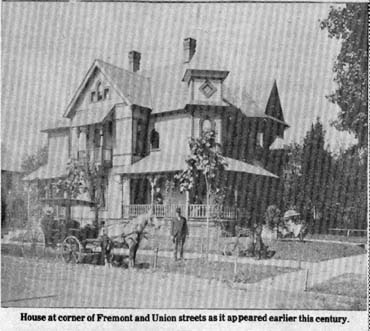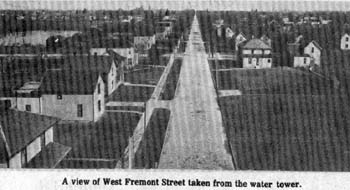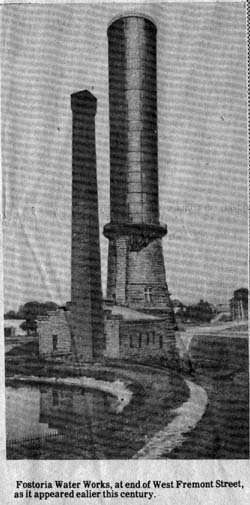September 13, 1979



Picture #1 – House at corner of Fremont and Union streets as it appeared earlier this century.
Picture #2 – A view of West Fremont Street taken from the water tower
Picture #3 – Fostoria Water Works, at end of West Fremont Street, as it appeared earlier this century.
Everywhere you look today there is evidence of the increased interest in historical subjects.
Libraries all over the U.A. report that there is an increased use of their history departments to dig out historical data about town, people, genealogy, etc. And those doing the “digging” aren’t always senior citizens.
Locally, there is also evidence of the interest in history, and the following list of activities support the trend:
Formation of Fostoria Area Historical Society several years ago. Formation of Fostoria Lineage Society. Formation of Antique Study Club and their Heritage House project. Growth of interest in museums in area where historical memorabilia is displayed. Interest of local groups to see Dan McGinnis’ slide presentation of old Fostoria scenes from the past.
The number of people of all ages studying the Bible (history) has also increased.
There is also a growing interest in town and cities where tour a are sponsored through landmark homes by various civic groups.
I would be remiss if I didn’t say something about the Potluck articles, which have been historically slanted since this column started in 1977.
As I go about town interviewing people for stories, and just talking to people, they express their gratitude for the historical data. Of course, the older readers who have lived in this area for many years are interested, but I also find many newcomers in town who are interested in learning about Fostoria’s past. Parents have also told me that their youngsters are interested. Parents also are saving articles and putting them in scrapbooks for their kids when they have grown.
Fostoria is full of interesting subjects to write about, and there are many photos of the past which interest people, but their isn’t enough space to present all that is available as fast as I’d like. Readers will have to be patient and hope that in time they will get published.
FREMONT STREET VIEWS
Today’s photos show views of subjects which will be familiar to older Fostorians, and surprising to others. All were taken on West Fremont Street sometime shortly after the turn of the century.
One picture shows the old water tower, or standpipe as it was often called at the Fostoria water works. It was used for water storage for many years, but the metal portion was dismantled in 1959.
The chimney shown in the photo was connected to the steam boiler which operated the pump forcing the water through the lines to homes and factories. In about 1954, the boiler was replaced by electric motors for venting a heating system, it is no longer as high as shown in the photo.
When I was a boy, visitors were allowed to ascend to the viewing area, part way up the tower, and get a view of Fostoria. It was from that point that the other photo was taken, looking east on Fremont Street. The intersection of Vine Street can be seen about midway in the photo. Also seen in the background on the left is Woods Pond, where Gray Park is now. It was a popular place for boys to swim in the summer, and for both boys and girls to skate in the winter.
The other photo with today’s column is of the W.C. Beckwith property at the corner of Union and Fremont street as it appeared many years ago. A view of it as it appears today was published in The Review Times recently. Your editor thought you would be interested in the beauty of the old home then, and what happens to fine old landmarks if they are not maintained.
The comparison is not meant to reflect on the present owners. Natural deterioration doesn’t happen during one ownership, but creeps up unsuspected if owners aren’t attentive.
It is a reminder that Fostoria’s fine old homes should be regarded as worth maintaining and restoring to their original status if at all possible. It may be a project that someone should undertake.
READER FEEDBACK: BASKET MARKET
In a recent Potluck column I promised to straighten out the location of the Basket Market from the time of its origin. A letter from Shirley Turner, Shirley (Doke) daughter of Robert Doke, the store’s originator; and a telephone call from Mrs. Namon Fruth, whose husband owned the store in later years, helped me.
Here’s the dope. The first Basket Market store was in the room where Commercial Printing is now, when Mr. Merganthaler owned the building. It had been a movie house previously. From there it moved to West Tiffin Street; then back to East Tiffin street in a room now part of the Preis Store, just west of Doug’s Tavern. At that time Namon Fruth was a partner and ran the meat department according to Mrs. Fruth.
Later, Doke sold out to Fruth and the store moved to the room next to Commercial Bank (uptown branch).
It was then that Doke realized he wasn’t reader to retire, and he started another store in a cement block building in the alley between Center and Tiffin. That’s the location I mentioned in Potluck Aug. 16, 1979, which caused readers to question.
ARMORY STORY
The article about the armory (Aug. 9, 1979) brought many responses, the most important being the one that surfaced when John Lee, Charles Hershberger, and Louie Bauer got together to exchange memories. They remembered something I never knew – that at one time after the building was no longer an armory, it was used for a basketball court. That must have been when it was also a skating rink.
Their story was that Bill Ellis and his Kenton Reds team played there on several occasions. Ellis will be remembered as a local tailor, in addition to being a basketball pro. I was informed by Charles Hershberger that the Kenton Reds defeated the Boston Celtics at one time.
At one time when the local YMCA was without a physical director, Ellis filled in. Because he taught the boys his basketball skills, Fostoria High School had some winning seasons.